Source: official account: comprehensive research on optics and semiconductors
The attosecond (as) is three orders of magnitude smaller in time than the femtosecond. According to the time bandwidth product, the spectral bandwidth must be three orders of magnitude larger to support such pulses. At the same time, it implies that attosecond pulses must be in short wavelengths (UV or X-ray bands) because electromagnetic wave pulses cannot be shorter than half a cycle of the carrier wave. The center wavelength of a three period, 50as pulse must be 50nm, corresponding to a photon energy of approximately 25eV. The shortest attosecond pulse currently measured is 67as, with a center wavelength of 50nm and a bandwidth support of 30as.
There are three main methods for generating attosecond pulses: one is the high-order harmonic method; The second is a free electron accelerator; The third is the plasma reflector. This article mainly focuses on the first method, which is the generation technology of high-order harmonics and single attosecond pulses of atoms under the action of femtosecond light field.
Nonlinear Optics of Bound State Electrons
Electrons in atoms are confined in potential wells. Although the single photon energy of visible light wavelengths (several eV) cannot ionize inert gas atoms (tens of eV), under strong light fields, multiphoton absorption and ionization occur, causing electrons to break free from the confinement of atomic nuclei This ionization can be divided into multiphoton ionization or threshold ionization (also known as threshold ionization), tunneling ionization, and barrier ionization or barrier suppression ionization based on the strength of the light field. The following are simple images of these three situations, where the ionization energy of electrons is shown and E is the amplitude of the light field. Essentially, they are all multiphoton ionization Threshold ionization is the ionization in which an atom absorbs more photons than its first ionization energy in multiphoton ionization (Figure (a)). When tunnel ionization occurs, the intensity of the light field has already tilted and narrowed the atomic potential barrier, making it easier for electrons to pass through (Figure (b)). In ionization on the potential barrier, the instantaneous electric field has already pressed the potential barrier of the atom below the ionization energy, allowing electrons to easily break free from the atom's confinement (Figure (c)).
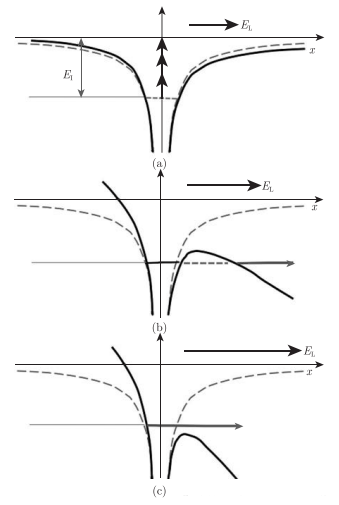
Ionization energy and kinetic potential
Simple images can help us qualitatively understand the emission mechanism of high-order harmonics, which can be analogized to the photoelectric effect discovered by Einstein. The photoelectric effect formula is
Among them, Ek is the maximum kinetic energy of the electron, and We is the electron's extraction work from the material This formula not only tells us that photon energy is quantized, but also that the maximum kinetic energy obtained by photoelectrons from photons is the photon energy minus the material's extraction work On the other hand, the energy of a photon is equal to the material's extraction work plus the maximum kinetic energy of an electron In the era of lasers, Einstein's photoelectric effect formula needs to be modified The energy of injecting multiple high-intensity infrared or visible light photons into an atom or molecule simultaneously can be m times the photon energy: mhv, which can overcome the work function We. Experiments have shown that multiphotons can indeed overcome the extraction work of metals, but the reason why they are not commonly used is that multiple infrared photons have lower excitation efficiency than a single ultraviolet photon, and the high pulse power required for multiphotons can easily damage the metal surface On the other hand, the electric field intensity of laser pulses with extremely high peak power can reach 1V/A, which tilts the Coulomb field of bound electrons (as shown in the figure below), making it easier for electrons to break free from their confinement. Once freed from the confinement of the Coulomb field, electrons will "oscillate" with the oscillation of the laser field, and this "oscillation" energy, now known as the "harmonic potential", is the source of high-order harmonics This was also something Einstein did not consider These oscillating electrons often 'oscillate' and fall off But sometimes, some electrons may be brought back to the vicinity of the parent nucleus by the light field, collide and recombine with it, and emit high-frequency photons - VUV or X-rays Every half cycle of the light field may cause some electrons to recombine and emit high-order harmonics.
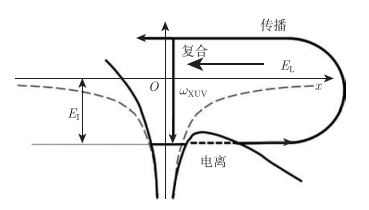
There are two characteristics of high-order harmonics (as shown in the figure below): ① The harmonic conversion efficiency first sharply decreases with the increase of harmonic order, but by the 7th to 11th order, the decrease becomes gentle, forming a wide plateau, and then there is a fast decreasing cut-off zone, and finally disappears near the energy equal to E+3.17Up. ② These commercial harmonics have only odd orders, as even commercial harmonics generated in opposite laser periods of the excitation laser field interfere and cancel each other out. This process shifts the femtosecond laser spectrum from visible light to the X-ray band.
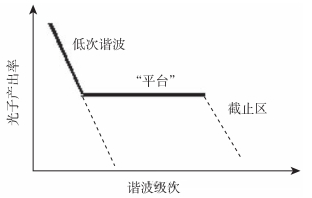
High harmonic generation technology
The commonly used high-order harmonic generation devices include hollow waveguide and jet Hollow core waveguide is designed to increase the interaction distance between laser and gas (Figure (b)), but due to dispersion, that is, the wavelength of the excitation light and the velocity difference of the generated high-order harmonics in the gas, this effect may be periodically reversed. Jet is used to create a very thin and dense gas medium, and there is no gas absorption in the path of the laser reaching the gas flow. For example, in Figure (a), the gas pressure in the gas chamber is less than 1mbar. In addition to gas, the plasma generated by the ultra short pulse vaporization of solid targets, especially metal targets, can also serve as a medium for high-order harmonic generation. The main direction of high-order harmonic generation is to improve efficiency and photon flux of X-rays These two indicators strongly depend on cumulative effects such as transmission and phase matching.
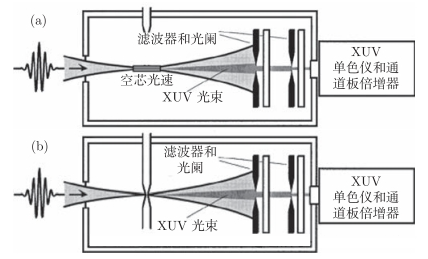
The generation of isolated attosecond pulses
Each harmonic in high-order harmonics corresponds to a sub femtosecond or attosecond pulse, but because they are stacked together in time, they cannot be separated and cannot be measured or utilized. Therefore, generating isolated (single) attosecond pulses becomes very important There are generally two methods for generating isolated (single) attosecond pulses One is a single cycle pulse controlled by carrier phase, and the other is excited by high-speed rotating polarization state pulses.
Carrier envelope phase control
In multi cycle laser pulses, attosecond pulses are generated once every half optical frequency cycle. If electrons and atomic nuclei can only collide once during the laser pulse time, isolated, single attosecond pulses can be generated When the pulse approaches a single optical period, the excitation pulse drives the width of each harmonic of the high-order harmonics to expand to adjacent harmonics, and the interaction between high-order harmonics significantly improves the temporal coherence characteristics between harmonics, even producing a supercontinuum spectrum, which is an independent X-ray pulse with a pulse width of about 100as.
For periodic pulses, the relative position between the pulse envelope and the peak of the pulse electric field, i.e. the phase of the pulse carrier envelope, greatly affects the instantaneous amplitude of the pulse electric field, resulting in a significant variation in Up that cannot be simply determined by the electric field of the pulse envelope. Moreover, the timing and frequency of electron recombination with its parent nucleus are determined by the relative position of the electric field, resulting in significantly different characteristics of high-order harmonics near the cutoff frequency. If the excitation pulse is shortened to the period level, there will only be one period of electric field oscillation under the envelope of the newly launched pulse. Therefore, electrons only collide with atomic nuclei in the middle part of the pulse electric field, emitting higher-order harmonic wave packets near the center of the pulse. When the phase is newly set sail, there may be two harmonic emissions close to the cutoff frequency. When the carrier envelope phase sets sail, the electron and its parent nucleus recombine to emit a supercontinuum wave near the cutoff frequency, which corresponds to a single sub femtosecond X-ray pulse in the time domain; When the phase is newly set sail, this harmonic pulse will recover as a discrete harmonic in the spectral domain, and in the time domain, it is a pulse train composed of several pulses. Another advantage of exciting high-order harmonics with short pulses is that ionization saturates at relatively high electric field values, thus extending the harmonic spectrum to higher frequencies.
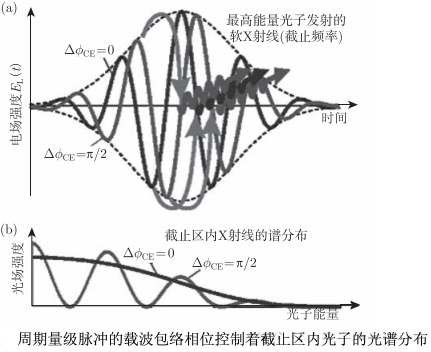
Polarization control
Although single cycle pulses controlled by carrier envelope phase can generate isolated attosecond pulses, the generation of single cycle pulses itself requires very high technology If we understand that the key to generating isolated attosecond pulses is that electrons collide and recombine with their parent nucleus only once during the pulse time, we can come up with other solutions. Simulation results show that the probability of electron re collision decreases as the ellipticity of polarization increases If such a pulse can be manufactured, whose polarization state is circularly polarized at both the rising and falling edges of the pulse, and linearly polarized at the peak of the pulse, it can ensure that electrons only collide with the atomic nucleus once. Only in the middle part of the pulse can attosecond pulses be effectively generated, which is called polarization gating or polarization gating.
It is easy to make such a shutter: divide a pulse into two parts in space, use two half wave plates with fast and slow axes perpendicular to each other, and apply phase delay to the two beams of light separately. The upper and lower beams of light will have circular polarization states in opposite directions At the focal point, where two beams of light overlap, opposite polarized light overlaps to form polarized light. Controlling the time delay between two pulses can control the direction of polarization.
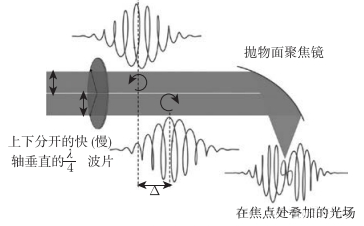
If the above two methods are combined, that is, single cycle pulse combined with polarization control, it is possible to obtain shorter attosecond pulses.
Disclaimer: This article is reproduced or adapted online, and the copyright belongs to the original author. The content of the article is the author's personal opinion. Reproduction is only intended to convey a different viewpoint and does not represent the company's endorsement or support of that viewpoint. If you have any objections, please feel free to contact us.